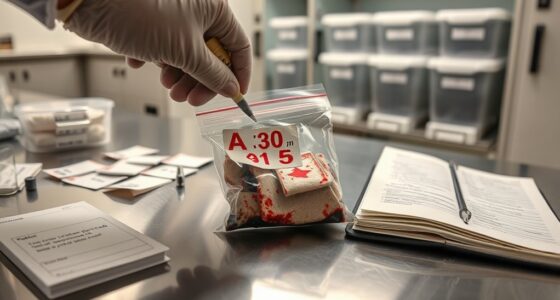To conquer jitters in haunted places, focus on building mental resilience through visualization, mindfulness, and rituals that anchor your focus. Manage physiological reactions by practicing deep, controlled breathing and grounding techniques. Strengthen emotional control by processing feelings and sharing experiences with your team. Use technology like virtual simulations to familiarize yourself with the space beforehand. Developing a supportive team environment and employing these strategies can boost confidence—continue exploring these methods to master your fear.
Key Takeaways
- Build mental resilience through visualization, mindfulness, and ritual practices to stay focused and calm during investigations.
- Use controlled breathing and grounding techniques to manage physiological reactions like anxiety and trembling.
- Practice sensory grounding and emotional awareness to stay present and process fears effectively.
- Foster team cohesion and clear communication to provide emotional support and reduce individual jitters.
- Utilize technology such as virtual reality and sensory tools to familiarize with haunted spaces and desensitize fears.
Building Mental Resilience Before the Investigation

Before stepping into a haunted location, cultivating your mental resilience is essential so you can stay focused and calm under pressure. You can do this effectively through visualization exercises, where you imagine yourself handling eerie situations with confidence. Practice mental rehearsal by envisioning how you’ll respond to sudden noises or unsettling sights, reinforcing your readiness. These techniques help you build a mental shield against fear’s effects, enabling you to maintain composure in stressful moments. Regularly engaging in such exercises trains your mind to stay grounded, even when faced with the unknown. Recognizing and understanding narcissistic traits can also help you anticipate manipulative behaviors, reducing their emotional impact. Incorporating mindfulness practices like meditation enhances your ability to stay present and centered during tense situations. Developing emotional resilience further strengthens your capacity to withstand fear and stress during investigations. Understanding visualization techniques can deepen your mental preparation, making it easier to confront your jitters and approach your investigation with clarity and calmness. Over time, you’ll develop a stronger sense of control, making it easier to confront your jitters and approach your investigation with clarity and calmness.
Utilizing Rituals and Ritualistic Practices for Focus

Once you’ve strengthened your mental resilience, incorporating rituals can further sharpen your focus during investigations. Ritual symbolism helps anchor your mind, creating a sense of stability amid uncertainty. Light a candle or recite a personal mantra in sacred spaces, which are intentionally chosen or prepared areas conducive to spiritual focus. These ritualistic practices serve as mental cues, signaling your intent to remain calm and attentive. They establish a boundary between the ordinary and the paranormal, grounding you in the present moment. Consistently performing these rituals before and during investigations reinforces your focus, making it easier to filter out distractions and fear. Developing attention to detail during your preparations and investigations enhances your ability to notice subtle signs and anomalies. Implementing risk management strategies for your safety and the integrity of your investigation is also crucial. Awareness of psychological factors can help you manage fear responses effectively. Additionally, understanding the importance of environmental awareness can help you better interpret the clues you encounter. Engaging in proper safety precautions and creating a controlled environment can further enhance your confidence and concentration. Ultimately, ritual symbolism and sacred spaces act as tools that transform your mindset, empowering you to confront haunted environments with clarity and purpose.
Techniques for Managing Physiological Reactions to Fear

When fear starts to take over, using breathing control strategies can help you stay calm. Grounding and mindfulness techniques keep you centered, while physical relaxation methods reduce tension. Practicing these approaches can make a real difference when facing the unknown. Incorporating AI-powered tools can also assist in managing physiological reactions by providing real-time feedback and guidance during stressful situations. Additionally, understanding headphone compatibility concepts can help modulate stress by focusing on precision and control, much like fine-tuning a vehicle to optimize performance.
Breathing Control Strategies
Controlling your breathing is one of the most effective ways to manage physiological reactions to fear in haunted places. By practicing meditative breathing and diaphragmatic control, you can slow your heart rate and calm your nerves. Focus on deep, steady breaths that engage your diaphragm rather than shallow chest breaths. This technique helps reduce panic and keeps you centered. Use the table below to see how different breathing patterns can help:
| Technique | Benefit |
|---|---|
| Diaphragmatic control | Promotes deep relaxation |
| Slow, steady breaths | Lowers adrenaline and anxiety levels |
| Focused breathing | Enhances mental clarity |
| Mindful inhalations | Reduces physiological stress |
Mastering these strategies keeps your body in check, so fear doesn’t take over. Additionally, understanding the importance of breathing control strategies can significantly improve your ability to stay composed in frightening situations. Developing a consistent practice of regulated breathing techniques can further enhance your resilience when facing frightening environments. Recognizing how emotional regulation influences physical reactions can help you better manage fear responses during tense moments.
Grounding and Mindfulness
Grounding and mindfulness techniques help you stay present and focused when fear threatens to take over in haunted places. By practicing meditation techniques, you can center your mind and reduce anxiety. Sensory grounding is especially effective; focus on your senses to anchor yourself in the moment. Feel the texture of an object, listen to ambient sounds, or notice your breath. These simple actions redirect your attention away from fear and into the here and now. Regularly using grounding exercises strengthens your ability to manage physiological reactions like rapid heartbeat or trembling. Mindfulness encourages non-judgmental awareness of your feelings, helping you observe fear without becoming overwhelmed. With consistent practice, these techniques become powerful tools for maintaining composure amid spooky surroundings.
Physical Relaxation Techniques
After grounding yourself and becoming more aware of your feelings, focusing on physical relaxation can substantially reduce the physiological reactions to fear. One effective method is muscle relaxation, where you intentionally tense and then release different muscle groups to ease tension. Progressive stretching also helps calm your nervous system; gently stretch each muscle group, holding each position briefly before relaxing. These techniques lower your heart rate and reduce adrenaline, making it easier to stay composed in haunted environments. Consistently practicing muscle relaxation and progressive stretching before and during investigations can build resilience against fear’s physical effects. By controlling your body’s responses, you maintain better focus and confidence, turning fear into a manageable challenge rather than an overwhelming obstacle.
Developing a Support System and Team Dynamics

Building a strong support system and fostering effective team dynamics are essential when investigating haunted locations, as they help members stay focused and resilient amid unsettling situations. You should prioritize team bonding activities that build trust and camaraderie, making everyone feel more comfortable. Clear communication strategies are crucial; ensure everyone knows their roles, shares observations, and voices concerns without hesitation. Regular check-ins help identify stress points and reinforce unity. When team members support one another emotionally and professionally, it reduces jitters and enhances overall confidence. A cohesive team that communicates openly creates an environment where members feel safe to face fears and handle unexpected surprises. Strengthening these dynamics ultimately boosts your ability to succeed in even the most intimidating haunted investigations.
Using Technology as a Confidence Booster

When investigating haunted locations, leveraging technology can substantially boost your confidence and reduce jitters. Virtual reality allows you to familiarize yourself with the space before stepping inside, making the environment feel less intimidating. You can explore the layout, identify key spots, and even simulate encounters, which helps desensitize your fears. Sensory deprivation tools, like noise-canceling headphones or blindfolds, can help you control overwhelming stimuli, enabling you to focus and stay calm. Using these technologies gives you a sense of control, reducing anxiety and boosting confidence. By practicing with virtual scenarios and managing sensory input, you build mental resilience, making actual investigations feel less formidable. This strategic use of technology empowers you to face haunted locations with steadier nerves.
Post-Experience Reflection and Emotional Processing

Reflecting on your haunted location experience helps solidify your confidence and process any lingering emotions. After phantom encounters or intense moments, take time to analyze what you felt and observed. This emotional processing builds resilience, so future investigations feel less intimidating. Consider journaling your thoughts or discussing your experience with fellow investigators to gain perspective. Recognizing your emotional responses boosts resilience for upcoming challenges. To deepen your reflection, review this table:
| Encounter Type | Emotional Response | Next Steps |
|---|---|---|
| Phantom sighting | Fear, curiosity | Reassess evidence, stay grounded |
| Unexplained noise | Anxiety, intrigue | Practice calming techniques |
| Cold spots | Unease, fascination | Share experiences, reflect |
| Unexpected activity | Surprise, vulnerability | Strengthen emotional resilience |
This process helps you grow stronger, more confident, and ready for the next haunted adventure.
Frequently Asked Questions
How Do Investigators Handle Unexpected Supernatural Encounters During Investigations?
When you face unexpected supernatural surprises during investigations, stay calm and rely on your emergency preparedness. Keep your cool, document everything, and communicate clearly with your team. Trust your training to handle the situation safely, and don’t panic. Remember, paranormal surprises are rare, so focus on logical responses. Staying composed helps you gather valuable evidence and ensures everyone’s safety while traversing the unknown with confidence.
What Are the Best Ways to Recover Emotionally After a Terrifying Experience?
Facing fear can feel like a storm, but building emotional resilience helps you weather it. After a terrifying experience, focus on stress management techniques like deep breathing, journaling, or talking to someone you trust. Take time to process your emotions, remind yourself of your strength, and engage in calming activities. Over time, these strategies restore your confidence, allowing you to recover emotionally and face future challenges with renewed courage.
How Can New Team Members Quickly Build Trust Within the Group?
You can quickly build trust within your team by focusing on team bonding activities that encourage open communication and shared experiences. Be honest about your intentions, listen actively, and show reliability in your actions. Engaging in trust-building exercises helps break down barriers and fosters camaraderie, making everyone feel valued. As trust develops, your team will collaborate more effectively, creating a stronger, more unified group ready to face any challenge together.
What Safety Protocols Are Essential in High-Risk Haunted Locations?
Ever wondered what safety measures keep investigators safe in haunted locations? You should always wear protective gear like gloves and masks, and have clear emergency plans in place. These protocols guarantee you’re prepared for unexpected situations, like falls or sudden scares. Do you really want to risk injury or panic? Prioritizing safety with proper gear and plans helps you stay calm, focused, and confident while exploring high-risk haunted sites.
How Does Prior Personal Experience Influence Investigator Confidence Levels?
Your prior personal experience plays a vital role in boosting your confidence levels as an investigator. When you reflect on personal anecdotes of past successes or challenges, you build a sense of familiarity and control. This confidence building helps you stay calm and focused in haunted locations, reducing jitters. With each new experience, your confidence grows, making you more prepared and resilient for future investigations in high-risk environments.
Conclusion
By building mental resilience, utilizing rituals, managing physiological reactions, fostering team support, and leveraging technology, you create a fortress against fear. Each step strengthens your confidence, sharpens your focus, and deepens your resolve. As you face haunted places, let your mind be steady, your heart be brave, and your spirit be unwavering. Ultimately, it’s not just about confronting the unknown, but about becoming the fearless investigator who stands tall amidst the shadows.









